Massage therapy has a number of benefits for people of all ages. For those moving into the senior years of life, however, the benefits can be all the more advantageous.
As you age, joint movement becomes stiffer and less flexible.
This is because the amount of lubricating fluid inside your joints decreases and the cartilage becomes thinner. Massage assists to manage this by increasing circulation around the body to decrease inflammation in the joints and to keep the fluid moving.
This can prevent and relieve pain, all while boosting your mood, improving sleep, fighting depression, and more.
How massage therapy is being applied to seniors?
Massage therapy is the practice of kneading or manipulating muscles and other soft-tissue in order to improve health and wellbeing. Therapists hold, move, and apply pressure to the muscles, tendons, ligaments, and fascia in what is one of the oldest healing traditions used by the Ancient Greeks, Egyptians, Chinese, and Indians. There are also massage chairs available nowadays so you can enjoy massage therapy from home, which offer traditional Chinese full body massage, minimizing the strain of gravity on your vertebrae, relieving back pain, and offering a host of other benefits.
Performed in short sessions, massage therapy techniques can be altered to specifically service the aging body, preventing skin discoloration, bone and muscular deterioration, and respiratory problems such as emphysema and asthma.
Motions are comfortable and soothing to the body, designed to improve blood circulation and heart function, prevent diabetic complications, relieve muscle tension, and relax the body and mind.
How does massage therapy for seniors work?
Massage therapy helps the body heal. After just one session your body responds by increasing a gene responsible for mitochondria development – a cellular component often referred to as the “powerhouse” of the cell. The lifting and kneading of muscle tissue also ‘turn off’ genes associated with inflammation which helps to push lactic acid out of aching muscles.
Beyond the physical, massage therapy helps to relieve stress and strain that originates in the mind and reflects on the body. Symptoms of stress such as increased heart rate and pulse, heightened muscle preparedness, increased blood pressure, immune system suppression, lack of sleep – can all be reduced via massage therapy. The benefits of massage therapy are wide-ranging. Here are 5 benefits of massage therapy that you need to know.
1. Increases blood flow to limbs
Walking is the number one recommendation for improving circulation but massage can improve vascular function when exercise is limited. During the massage, the friction created stimulates the improvement in both blood and lymphatic circulation.
2. Softens hard muscles and tissues
The less active you are the more your muscles harden and tighten. Massage helps to raise muscle temperature, allowing the stretching and loosening of muscles to occur. This can lessen muscle tension and pain.
3. Improves balance and gait
Falling is the leading cause of unintentional injury in older New Zealanders and even the idea of falling can trigger a loss of confidence when out and about. Because massage improves blood flow to the limbs, it helps improve proprioception, thus improving your balance and gait and reducing your risk of falling.
4. Stimulates the nervous system
Massage therapy releases endorphins, hormones, and neurotransmitters that are beneficial to the functioning of the nervous system. This includes serotonin and dopamine, the “happy hormones”. If these strange pandemic times have put you on edge, a release of happy hormones might be just what you need to destress.
5. Improves sleep
The relaxation benefit of massage sets you up for relaxation beyond the massage table. It helps you to spend more time in deep sleep, the restorative stage in which the body barely moves. This is due to the release of serotonin, essential for the production of melatonin – the sleep-inducing hormone.
How to enhance the benefits of massage therapy?
Massage therapy can be pain-relieving and relaxing but to reap all the benefits it’s important you communicate with your massage therapist. You may prefer a lighter touch or firmer pressure, so talk to them about your needs and be clear about your goals.
When going for a massage, enhance the experience by avoiding caffeine which can cause muscle gripping and dehydration. Instead, drink plenty of water which will help to flush toxins out of the body and relax muscles faster.
Breathe into your message, turn off your mobile phone and consider adding aromatherapy. Lavender, for example, would be a calming scent if you suffer from insomnia while peppermint is great for pain relief.
Keep in mind too that massage therapy doesn’t need to break the bank. You can still access the many benefits of massage by using a foam roller, a handheld massager, or a massage pillow. However you perform it, your body and mind will thank you for the extra attention.




